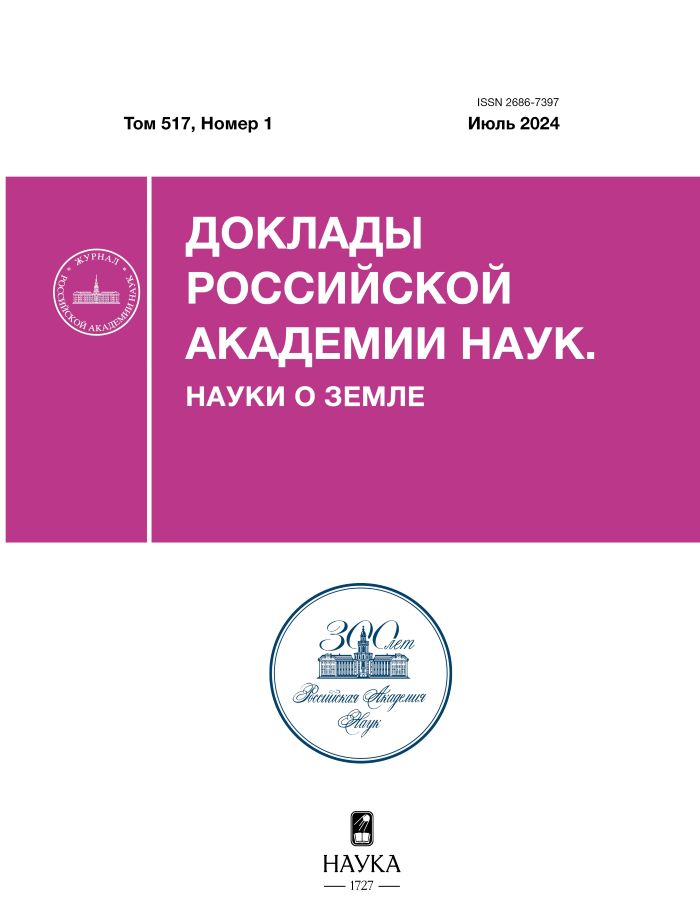Structural heterogeneities of lithium-bearing layered silicates of paleocarst kimberlites and their prospecting value (Middle-Markhinsky diamond-bearing region, Western Yakutia)
- Autores: Nikulin I.I.1, Boeva N.M.1, Bortnikov N.S.1
-
Afiliações:
- Institute of Geology of Ore Deposits, Petrography, Mineralogy and Geochemistry of the Russian Academy of Sciences
- Edição: Volume 517, Nº 1 (2024)
- Páginas: 99-113
- Seção: MINERALOGY
- ##submission.dateSubmitted##: 31.01.2025
- ##submission.datePublished##: 13.12.2024
- URL: https://ter-arkhiv.ru/2686-7397/article/view/650006
- DOI: https://doi.org/10.31857/S2686739724070114
- ID: 650006
Citar
Texto integral
Resumo
Clay minerals formed as a result of hydrothermal activity within kimberlite pipes were redeposited into the horizons of the Lower Jurassic diamondiferous deposits of the near-facies facies. The mineral composition of the Lower Jurassic Dyakhtar sequence, composed of paleodeluvium and paleokarst deposits, has been studied in the immediate vicinity and at a distance from kimberlite pipes. Mixed-layer minerals with structural heterogeneities, in which an increased concentration (up to 0.1 wt %) of lithium is noted, were found in sections of erosion plumes of weathered varieties of kimberlite rocks. The thickness of sediments with such minerals decreases sharply at distances of more than 2 km from the desired kimberlite body. The identified features in the mineral composition of the deposits overlying kimberlite pipes can be used as new prospecting signs of diamond potential during geological exploration of primary sources of diamonds.
Palavras-chave
Texto integral
Sobre autores
Iv. Nikulin
Institute of Geology of Ore Deposits, Petrography, Mineralogy and Geochemistry of the Russian Academy of Sciences
Autor responsável pela correspondência
Email: iinikulin@gmail.com
Rússia, Moscow
N. Boeva
Institute of Geology of Ore Deposits, Petrography, Mineralogy and Geochemistry of the Russian Academy of Sciences
Email: iinikulin@gmail.com
Rússia, Moscow
N. Bortnikov
Institute of Geology of Ore Deposits, Petrography, Mineralogy and Geochemistry of the Russian Academy of Sciences
Email: iinikulin@gmail.com
Academician of the RS
Rússia, MoscowBibliografia
- Граханов С. А., Шаталов В. И., Штыров В. А., Кычкин В. Р., Сулейманов А. М. Россыпи алмазов России. Новосибирск: Академическое изд-во “Гео”, 2007. 457 с.
- Барабаш Е. О., Афанасьев В. П., Похиленко Н. П., Малыгина Е. В., Иванова О. А. Оценка возраста и потенциальной алмазоносности коренных источников по их глубинным минералам из ореолов рассеяния // Отечественная геология. 2022. № 6. С. 3–16.
- Похиленко Н. П., Афанасьев В. П. Перспективы выявления кимберлитов с промышленной алмазоносностью на территории Сибирской платформы / В кн.: Научно-методические основы прогноза, поисков, оценки месторождений аламзов, благородных и цветных металлов. Сборник тезисов докладов ХII Международной научно-практической конференции. М., 2023. С. 375–379.
- Afanasiev V. P., Pokhilenko N. P. Approaches to the diamond potential of the Siberian craton: A new paradigm // Ore Geology Reviews. 2022. V. 147. 104980. https://doi.org/10.1016/j.oregeorev.2022.104980
- Morkel J., Vermaak M. K. G. The role of swelling clay in kimberlite weathering // Mineral Processing and Extractive Metallurgy. 2006. 115:3. P. 150–154. doi: 10.1179/174328506X109121.
- Agasheva E. Magmatic Material in Sandstone Shows Prospects for New Diamond Deposits within the Northern East European Platform // Minerals. 2021. 11. 339. https://doi.org/10.3390/min11040339.
- Калашников В. В., Ковалев Л. Н. Геологические работы в Республике Саха (Якутия) за 100 лет // Руды и металлы. 2022. № 2. С. 6–24. doi: 10.47765/0869-5997-2022-10007.
- Прокопчук Б. И., Левин В. И., Метелкина М. П., Шофман И. Л. Древний карст и его россыпная минерагения. М.: Наука, 1985. 175 с.
- Никулин И. И., Савко А. Д. Литология алмазоносных нижнеюрских отложений Накынского кимберлитового поля (Западная Якутия) // Труды научно-исследовательского института геологии Воронежского государственного университета. Воронеж: Воронежский государственный ун-т, 2009. № 56. 134 с.
- Никулин И. И. Экспресс-приемы выделения тонкодисперсных минералов из цемента осадочных пород // Вестник Воронежского государственного университета. Серия: Геология. 2010. № 1. С. 286–292.
- Шилин Д. М., Иванова В. П. Хлоритосодержащие породы / В кн.: “Измененные околорудные породы и их поисковое значение”. М.: Госгеолтехиздат, 1954. С. 148–193.
- Manuella F. C., Carbone S., Barreca G. Origin of Saponite-Rich Clays in A Fossil Serpentinite-Hosted Hydrothermal System in The Crustal Basement of The Hyblean Plateau (Sicily, Italy) // Clays Clay Miner. 2012. 60. 18–31. https://doi.org/10.1346/CCMN.2012.0600102
- Дриц В. А., Коссовская А. Г. Глинистые минералы: смектиты и смешанослойные образования. М.: Наука, 1990. Тр. ГИН АН СССР, вып. 446. 214 с.
- Зинчук Н. Н., Харькив А. Д., Котельников Д. Д., Соболева С. В. Флогопит и продукты его изменения в кимберлитовых породах Якутии // Минералы и парагенезисы минералов горных пород и руд. Л.: Наука, 1979. С. 69–81.
- Подгаецкий А. В., Котельников Д. Д. Кристаллохимические аспекты преобразования слоистых силикатов в кимберлитах трубки Катока, Ангола // Руды и металлы. 2006. № 1. С. 46–57.
- Ogorodova L. P., Kiseleva I. A., Mel’chakova L. V. et al. Calorimetric determination of the enthalpy of formation of natural saponite // Geochem. Int. 2015. 53. 617–623.
- Dill H. G. Kaolin: Soil, rock and ore: From the mineral to the magmatic, sedimentary and metamorphic environments // Earth-Science Reviews. 2016. V. 161. P. 16–129. https://doi.org/10.1016/j.earscirev. 2016.07.003.
- Saburo A., Norihiko K., Hiroshi H. Hydrothermal clay minerals found in sediment containing yellowish-brown material from the Japan Basin // Marine Geology. 1996. V. 129. № 3–4. P. 331–336. https://doi.org/10.1016/0025-3227(96)83351-2
- Зинчук Н. Н., Соболева С. В., Котельников Д. Д. Особенности слоистых силикатов из кимберлитов и вмещающих пород в зонах активного воздействия траппового магматизма (на примере Якутии) // Докл. АН СССР. 1989. Т. 305. № 5. С. 1199–1202.
- Morkel J., Kruger S. J., Vermaak M. K. G. Characterization of clay mineral fractions in tuffisitic kimberlite breccias by X-ray diffraction // The Journal of The South African Institute of Mining and Metallurgy. 2006. V. 106. P. 397–406.
Arquivos suplementares















